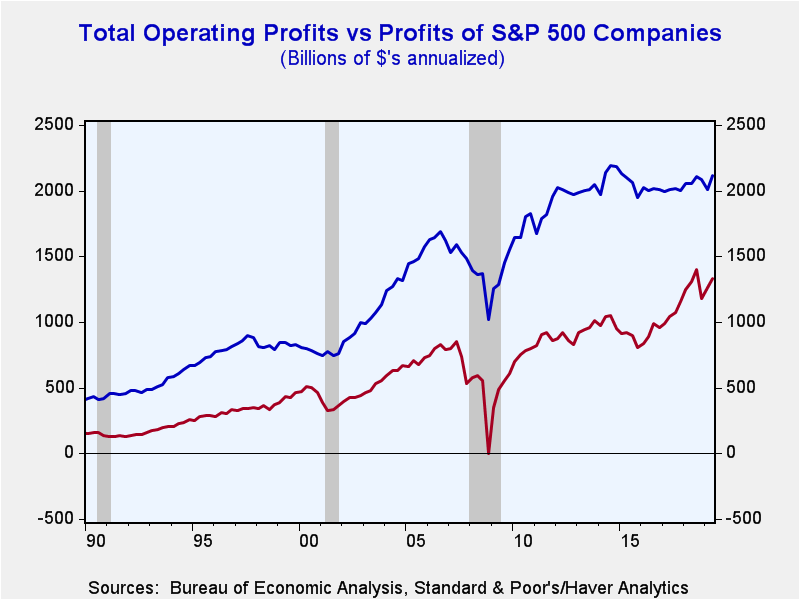 Global| Sep 24 2019
Global| Sep 24 2019The Profits Puzzle
|in:Viewpoints
Summary
Operating profits for the overall economy have been essentially flat since 2014. Yet, during the same 5-year period operating profits for the S&P 500 companies are estimated to be up by a third. Taken at face value, the profits data [...]
 Operating profits for the overall economy have been essentially flat since 2014. Yet, during the same 5-year period operating profits for the S&P 500 companies are estimated to be up by a third.
Operating profits for the overall economy have been essentially flat since 2014. Yet, during the same 5-year period operating profits for the S&P 500 companies are estimated to be up by a third.
Taken at face value, the profits data paints a picture of rising earnings for the companies that comprise the S&P 500 index while profits for millions of other firms are stagnant, if not contracting. How can that be? Are the earnings of S&P 500 companies "real" or are accounting gimmicks inflating them?
According to corporate profit data from the Bureau of Economic Analysis (BEA) operating profits for all US corporations (large and small and public and private) totaled $2.113 trillion in Q2 2019 essentially unchanged from the 2014 full year profit figure of $2.120 trillion.
Over the same 5-year period, the operating profits of S&P 500 companies have increased from $1.004 trillion in 2014 to an annualized estimated figure of $1.333 trillion in Q2 2019, and increase of 33%.
Both estimates of profits calculate earnings as the difference between receipts and expenses. Yet, the profit reports are based on two different accounting frameworks, financial and tax accounting.
Companies' use financial accounting to report their results, while tax accounting results is the primary source for the GDP measure of profits. As a result, differences between the two profit measures can result from the timing of when receipts and expenses are recorded, as well of what is included and not included in receipts and expenses.
For example, the GDP gauge of operating profits adjusts for misreported and/or overstated measures of current income. Income or losses derived from capital sales are not part of the GDP measure of profits because they reflect the sale of existing assets and GDP is only measuring the profits from current production, and not the change in the valuation of items that were produced in previous periods.
Yet, S&P 500 profits, which are based on a financial accounting basis, do include income derived from capital sales, and other financial flows and adjustments as well.
At the currently reported levels for Q2 2019 S&P 500 profits amount to a record 63% of overall operating profits for all US companies. In the past 30 years there is only one other period when the share of S&P 500 earnings topped the 60% level. That occurred in the late 1990s when the large gain in reported S&P 500 profits was largely driven by capital gain income. And, during that period the GDP measure of operating profits followed a similar pattern to that of 2014 to 2019---flat to slightly down.
Corporate profits are an important measure of the economy's overall performance as well as benchmark for the financial health of the corporate sector. The overall profit data raises questions about the general health of corporate sector. Moreover, the relative surge in S&P 500 earnings appears to be driven not by core operations and the experience of the late 1990s would argue that they unsustainable in their current form.
Viewpoint commentaries are the opinions of the author and do not reflect the views of Haver Analytics.Joseph G. Carson
AuthorMore in Author Profile »Joseph G. Carson, Former Director of Global Economic Research, Alliance Bernstein. Joseph G. Carson joined Alliance Bernstein in 2001. He oversaw the Economic Analysis team for Alliance Bernstein Fixed Income and has primary responsibility for the economic and interest-rate analysis of the US. Previously, Carson was chief economist of the Americas for UBS Warburg, where he was primarily responsible for forecasting the US economy and interest rates. From 1996 to 1999, he was chief US economist at Deutsche Bank. While there, Carson was named to the Institutional Investor All-Star Team for Fixed Income and ranked as one of Best Analysts and Economists by The Global Investor Fixed Income Survey. He began his professional career in 1977 as a staff economist for the chief economist’s office in the US Department of Commerce, where he was designated the department’s representative at the Council on Wage and Price Stability during President Carter’s voluntary wage and price guidelines program. In 1979, Carson joined General Motors as an analyst. He held a variety of roles at GM, including chief forecaster for North America and chief analyst in charge of production recommendations for the Truck Group. From 1981 to 1986, Carson served as vice president and senior economist for the Capital Markets Economics Group at Merrill Lynch. In 1986, he joined Chemical Bank; he later became its chief economist. From 1992 to 1996, Carson served as chief economist at Dean Witter, where he sat on the investment-policy and stock-selection committees. He received his BA and MA from Youngstown State University and did his PhD coursework at George Washington University. Honorary Doctorate Degree, Business Administration Youngstown State University 2016. Location: New York.


